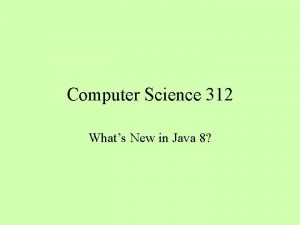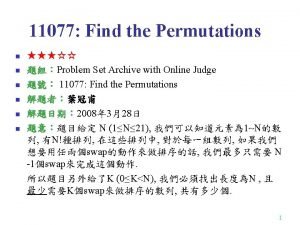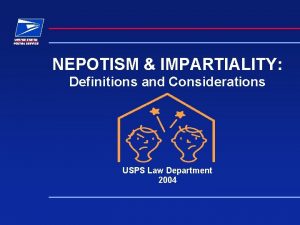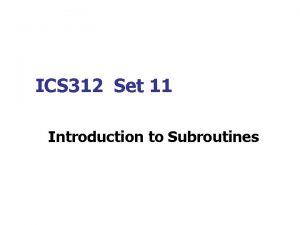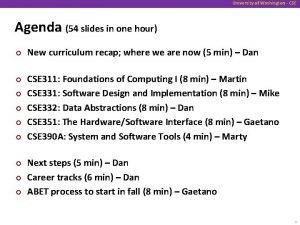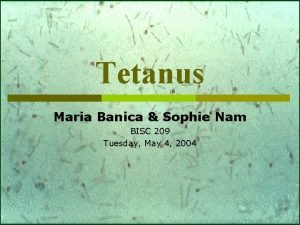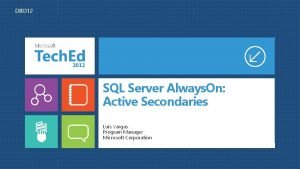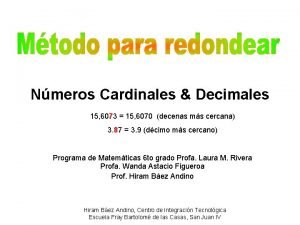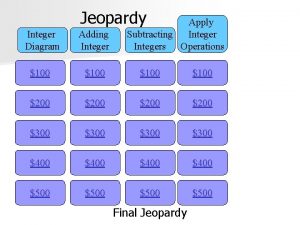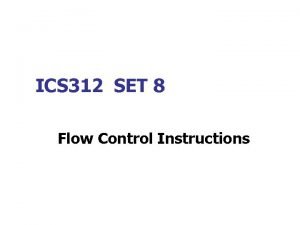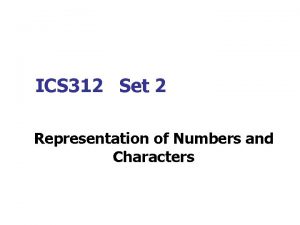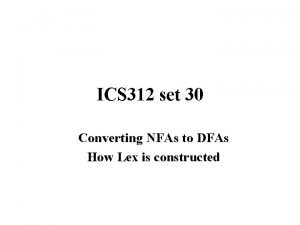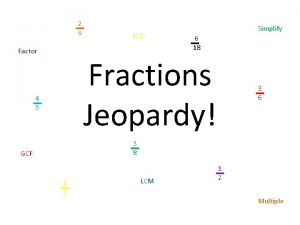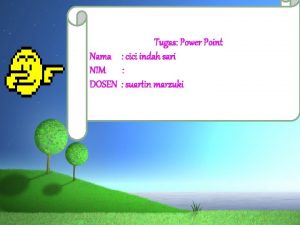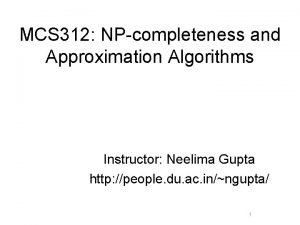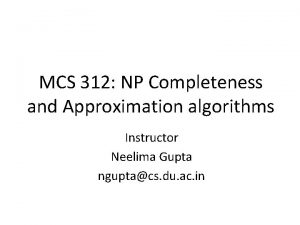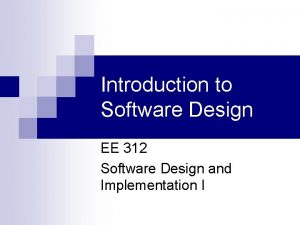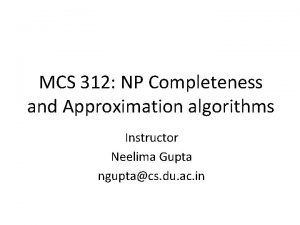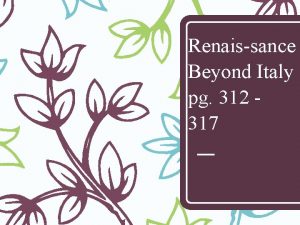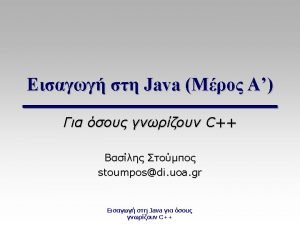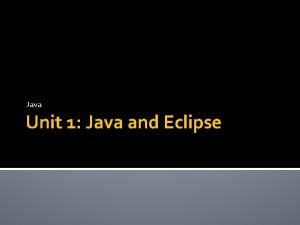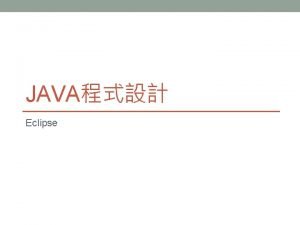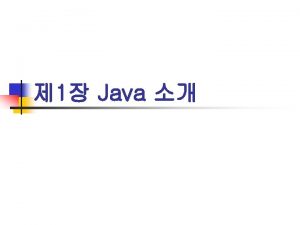Computer Science 312 Whats New in Java 8



























- Slides: 27

Computer Science 312 What’s New in Java 8?

What Is Pipelining? • Unix (or Linux) allows you to “pipe” data through a series of transformations using the | operator cat file 1 file 2 | tr "[A-Z]" "[a-z]" • Transformations: o o Glue two files together Convert the result to lowercase Sort the resulting lines Return the last three of those lines | sort | tail -3

st 21 Century Computing • Enormous amounts of data to be processed (“Big Data”) • Many CPUs are available, either via multicore or on a network • Would like a way of harnessing multiple processors to massage these data in a pipelined fashion, while using a simple, declarative style in our code

st 21 Century Computing • In functional languages, data can be pipelined through a series of transformations, using a highlevel, declarative style • Essential elements: o Map o Filter o Reduce (fold) o Lambda expressions

st 21 Century Computing • Because functional languages forbid side effects, the work of these transformations can be dispatched to multiple processors • Essential elements: o Map o Filter o Reduce (fold) o Lambda expressions

What about the Rest of Us? • In most conventional languages, massaging data involves iterating through various types of collections to modify their elements; the style of this is anything but declarative • Although object orientation mitigates the potential for harmful side effects, programs in most conventional languages suffer the pitfalls of managing shared memory when resorting to concurrency

Java 8 to the Rescue! • Java 8, released in 2014, includes new features that allow programs to process data in a pipelined manner, across multiple CPUs, with a declarative style of code • The new features are o o Streams (including parallel streams) Methods (including lambdas) as arguments Higher-order functions for mapping and filtering Higher-order functions for collecting results

Sorting the Old-Fashioned Way // java. util. Comparator public interface Comparator<T> { public int compare(T o 1, T o 2); } // java. util. Collections. sort static <T> void sort(List<T> list, Comparator<? super T> c) Collections. sort supports the strategy pattern Define a class that implements Comparator and pass an instance of this class to sort, for a particular type of comparison

Sorting the Old-Fashioned Way // java. util. Comparator public interface Comparator<T> { public int compare(T o 1, T o 2); } // java. util. Collections. sort static <T> void sort(List<T> list, Comparator<? super T> c) Collections. sort(inventory, new Comparator<Apple>() { public int compare(Apple a 1, Apple a 2){ return a 1. get. Weight(). compare. To(a 2. get. Weight()); } }); An instance of the strategy pattern Clunky: must create an instance of an anonymous class

Generalized Sorting with a lambda // java. util. Comparator public interface Comparator<T> { public int compare(T o 1, T o 2); } // java. util. Collections. sort static <T> void sort(List<T> list, Comparator<? super T> c) inventory. sort( (Apple a 1, Apple a 2) -> a 1. get. Weight(). compare. To(a 2. get. Weight())); Still a strategy, but we now pass an explicit behavior, without the extra fluff of a class definition Much more declarative in style!

Syntax of Java Lambdas (<parameters>) -> <expression> (<parameters>) -> {<statements> ; } (Apple a) -> a. get. Weight() > 150 (Apple a 1, Apple a 2) -> a 1. get. Weight(). compare. To(a 2. get. Weight()) (int x) -> x + 1

Filtering the Old-Fashioned Way

Filtering the Java 8 Way

Pass Method References filter. Apples(inventory, Apple: : is. Green. Apple); filter. Apples(inventory, Apple: : is. Heavy. Apple);

Or Pass Lambda Expressions filter. Apples(inventory, (Apple a) -> "green". equals(a. get. Color()) ); filter. Apples(inventory, (Apple a) -> a. get. Weight() > 150 );

Generalize to a filter Method static <T> Collection<T> filter(Collection<T> c, Predicate<T> p){ // Build and return a collection of filtered results } filter(inventory, (Apple a) -> "green". equals(a. get. Color()) ); filter(inventory, (Apple a) -> a. get. Weight() > 150 ); Could do this, but we won’t Instead, we’ll create a stream from the collection, use the filter method in the java. util. stream API on this stream, and collect the results

What Are Streams? • A stream is an abstraction of a sequence of data • Each data value is provided on demand • Unlike collections, streams can be lazy (even infinite) • Like video streaming vs a DVD

Streams vs Collections • Collections are used to store and manage data • Streams are used to process these data • Stream processing o Hides procedural details of iteration o Supports optimizations like parallel processing

Stream, Filter, and Collect import static java. util. stream. Collectors. to. List; List<Apple> green. Apples = inventory. stream(). filter((Apple a) -> "green". equals(a. get. Color()). collect(to. List()); List<Apple> heavy. Apples = inventory. stream(). filter((Apple a) -> a. get. Weight() > 150). collect(to. List()); Instead, we’ll • create a stream from the collection • use the filter method in the java. util. stream API on this stream • collect the results

To Stream or to Parallel Stream? Sequential stream: import static java. util. stream. Collectors. to. List; List<Apple> heavy. Apples = inventory. stream(). filter((Apple a) -> a. get. Weight() > 150). collect(to. List());

To Stream or to Parallel Stream? Sequential stream: import static java. util. stream. Collectors. to. List; List<Apple> heavy. Apples = inventory. stream(). filter((Apple a) -> a. get. Weight() > 150). collect(to. List()); Parallel stream: import static java. util. stream. Collectors. to. List; List<Apple> heavy. Apples = inventory. parallel. Stream(). filter((Apple a) -> a. get. Weight() > 150). collect(to. List());

Parallelize! sorted. Big. Data = big. Data. parallel. Stream(). sorted(). collect(to. List());

What’s Needed for Data Processing • A data source on which to open a stream • A set of intermediate operations to transform these data (map, filter, sorted, etc. ) • A terminal operation (collect, count, etc. ) to collect the results

Which Operations Are Intermediate and Which Are Terminal? long count = menu. stream(). filter(d -> d. get. Calories() > 300). distinct(). limit(3). count();

Reducing (Folding) int sum = numbers. stream(). reduce(0, (a, b) -> a + b); int product = numbers. stream(). reduce(1, (a, b) -> a * b); int sum = numbers. stream(). reduce(0, Integer: : sum); Optional<Integer> sum = numbers. stream(). reduce((a, b) -> (a + b));

Other Cool Stuff in Java 8 • Default methods – can include method implementations in an interface, so implementers of its classes won’t go crazy when new methods are added • Optional types – no more null pointer exceptions, due to having to return either null or some fullfledged object; specifies the Optional<T> type with accessor methods

For next time More Design Patterns
 Java 8 312
Java 8 312 Hashim: what's your favorite subject
Hashim: what's your favorite subject Cse 312
Cse 312 123+132+321+312
123+132+321+312 El 312 usps
El 312 usps Ics 312
Ics 312 Cse 312
Cse 312 Natural hazards definition ap human geography
Natural hazards definition ap human geography Po box 30512 salt lake city
Po box 30512 salt lake city Uw cse 312
Uw cse 312 Bisc 312 usc
Bisc 312 usc Altivar 312 solar
Altivar 312 solar 2-312
2-312 Ssis 312
Ssis 312 21 cfr part 312
21 cfr part 312 312 bus
312 bus 1053 enteros 246 milésimos
1053 enteros 246 milésimos What is the difference between 29 028 and 1 312
What is the difference between 29 028 and 1 312 Katherine is very interested in cryogenics
Katherine is very interested in cryogenics Flow control instructions
Flow control instructions Ics 312
Ics 312 Ics 312
Ics 312 Simplify. 312+18
Simplify. 312+18 Lebar balok
Lebar balok Mcs 312
Mcs 312 Mcs 312
Mcs 312 Ee 312
Ee 312 Mcs 312
Mcs 312
